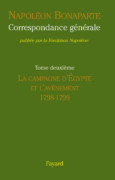The Correspondence of Napoleon
In 2002, the Fondation Napoléon launched its project to publish the General Correspondence of Napoleon Bonaparte. It was jointly initiated by Baron Gourgaud, then president of the Fondation Napoléon, Thierry Lentz, director of the Fondation Napoléon, and the Fondation’s board of directors, and the first volume was published in 2004. It was completed in 2018 with the publication of the fifteenth and last volume.
THE CORRESPONDANCE ONLINE AT THE WEBSITE NAPOLEONICA® LES ARCHIVES
From May 2022, the volumes of the General Correspondence of Napoleon Bonaparte will gradually be put online.
Eighteen years after its publication, the first volume of Napoleon Bonaparte’s Correspondence, which contained 2,283 letters written between 1784 and 1797, annotated by historians, will be made available online in May 2022 on the digitised archive site www.napoleonica.org. Many letters, discovered since the publication of the print edition, have also been put online: this first corpus thus presents (as of May 2022) 2,647 annotated letters.
The entire set of 15 volumes of Napoleon’s correspondence, augmented with many unpublished items since its publication in print, will be put online by the end of 2023.
► Read the press release Fondation Napoléon
► Access Napoleon’s letters on Napoleonica® les archives and learn more about this corpus (in English)
Video: presentation by François Houdecek, (responsible for editing the “General Correspondence of Napoleon Bonaparte”, and in charge of special projects at the Fondation Napoléon) © Fondation Napoléon 2022. You can watch this video with English subtitles by clicking on the Settings wheel at the bottom of the YouTube window.
A LOOK BACK AT THE EDITORIAL ADVENTURE
A few figures give an idea of the scale of the enterprise:
- 15 volumes;
- 40,497 published letters: of which 23,717 (58.5%) were not included in correspondence published during the Second Empire; 11,938 letters (29.5%) were previously unpublished, or only partially cited elsewhere;
- 40% of the texts were established after original drafts signed by Napoleon;
- 25 essays, 82 maps;
- 19,000 biographical notes;
- 15 detailed timelines;
- 456 participants.
The project was overseen by a publishing committee for the General Correspondence of Napoleon, led by the president of the Fondation Napoléon, Victor André Masséna, Prince d’Essling. The vice-presidents were Mme Martine de Boisdeffre, conseiller d’État and Pesident of the Cour administrative d’appel de Versailles, Director of the Archives de France from 2001 to 2010, and professors and members of the Institut de France Jean-Claude Casanova and Jean Tulard.
The board of directors of the Fondation Napoléon comprised a steering committee, along with another committee responsible for the academic and editorial work, the historical committee, led by Professor Jean-Claude Casanova, member of the Institut de France.
The Fondation Napoléon received financial support for this project from the Archives de France, the Fondation La Poste and the Service Historique de la Défense
The need for a new edition
Since the end of the First French Empire, there have been numerous collections of Napoleon’s letters, which has made any study of them a lengthy and tedious process. The Correspondence published during the Second Empire, owing to its political and hagiographical nature, was in fact only a very partial synthesis, and of a corpus which was itself already very scattered. Furthermore, the selection of letters and interference with the texts by the Commission Historique rendered this a biased work, provoking a considerable volume of criticism from the moment it was published. From the 1880s onwards and throughout the 20th century, historians and archivists have laboured to complete and correct the work published during the Second Empire.
“An industrial-scale project”
Centralising the thousands of Napoleon’s letters scattered throughout France and abroad made it essential to establish a rigorous and methodical working system.
National and local archive centres in some forty countries were contacted, along with museums and associations, making nearly 200 institutions which have taken part in the project. Private collectors were also targeted in a big campaign to raise awareness of the project. Furthermore, the committee has gone through more than 350 monographs and journals, as well as the collection of sales catalogues of the French National Archives (AB XXXVIII).
The scale of this work made it essential to appeal for voluntary help. Over 450 individuals have assisted the Fondation since the beginning of the project, and nearly 90 volunteers are currently involved in the project.
Letters are processed by some fifty voluntary “corresponding members” all passionately interested in history and Napoleonic history in particular. They come to the Fondation to work on enriching the database developed by Télécom Étude. Each letter is broken down into about twenty keywords to make it easier to manage the Correspondence. The database entries, a real pedigree of the letters, centralise all the data known about the documents: type, source, sale, publication etc., and make sure that they can be traced.
The annotation is, for its part, was taken care of by historians including former scholarship holders of the Fondation, students, etc. They were supervised by the volume editors who were responsible for finalising the annotations and generating the index.
Coordination of this work at the Fondation Napoléon was the task of François Houdecek, who was in turn supported by the entire body of staff at the Fondation Napoléon.
Each volume of the General Correspondence is designed to be a complete ressource. The corpus of letters is supplemented by studies which clarify sets of themes developed in Napoleon’s correspondence. A series of appendices (maps, conversion tables, chronological tables) and three indexes (biographical, index of institutions, index of places of publication) complete each volume.
Updated 17 May 2022





